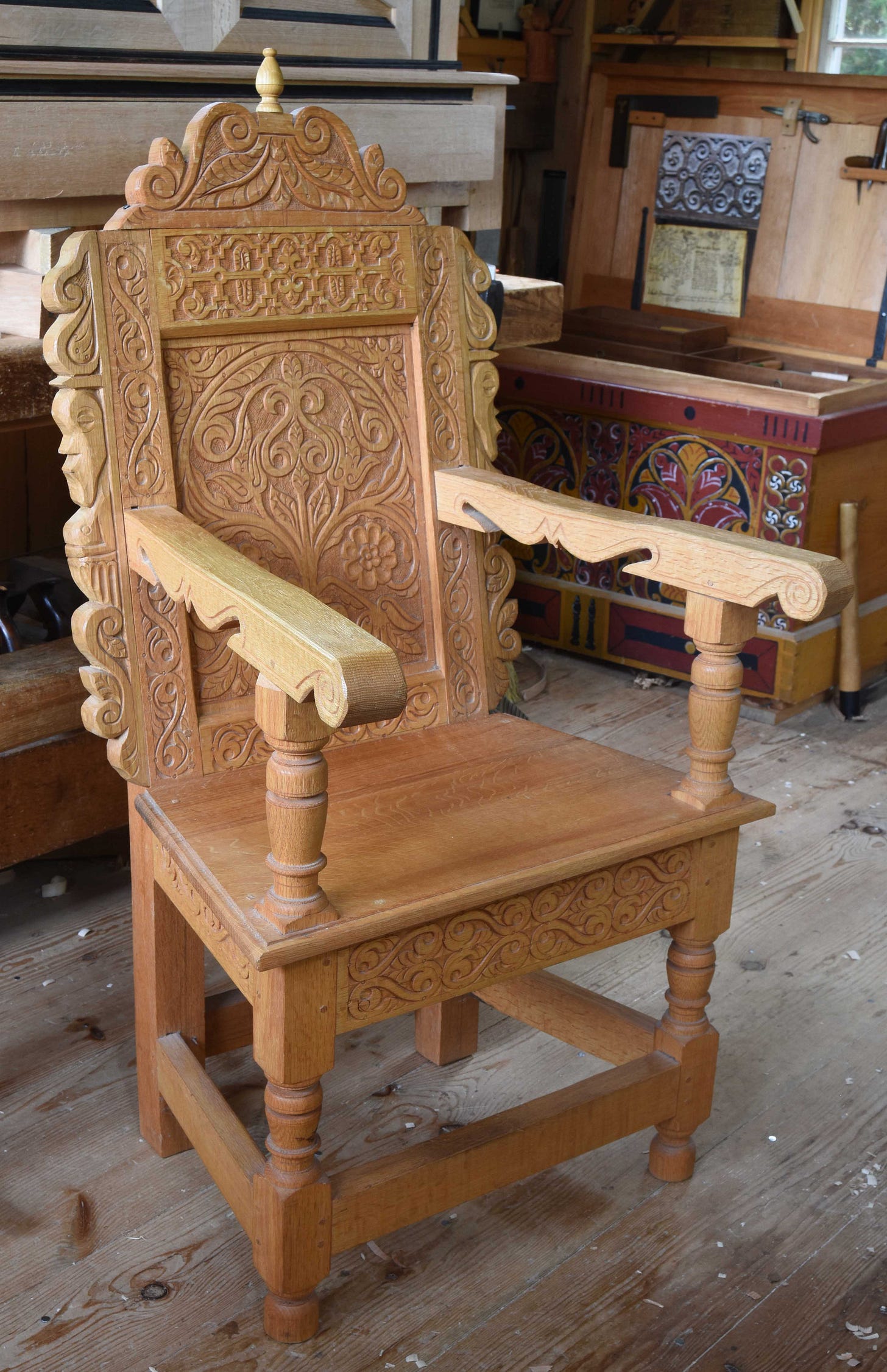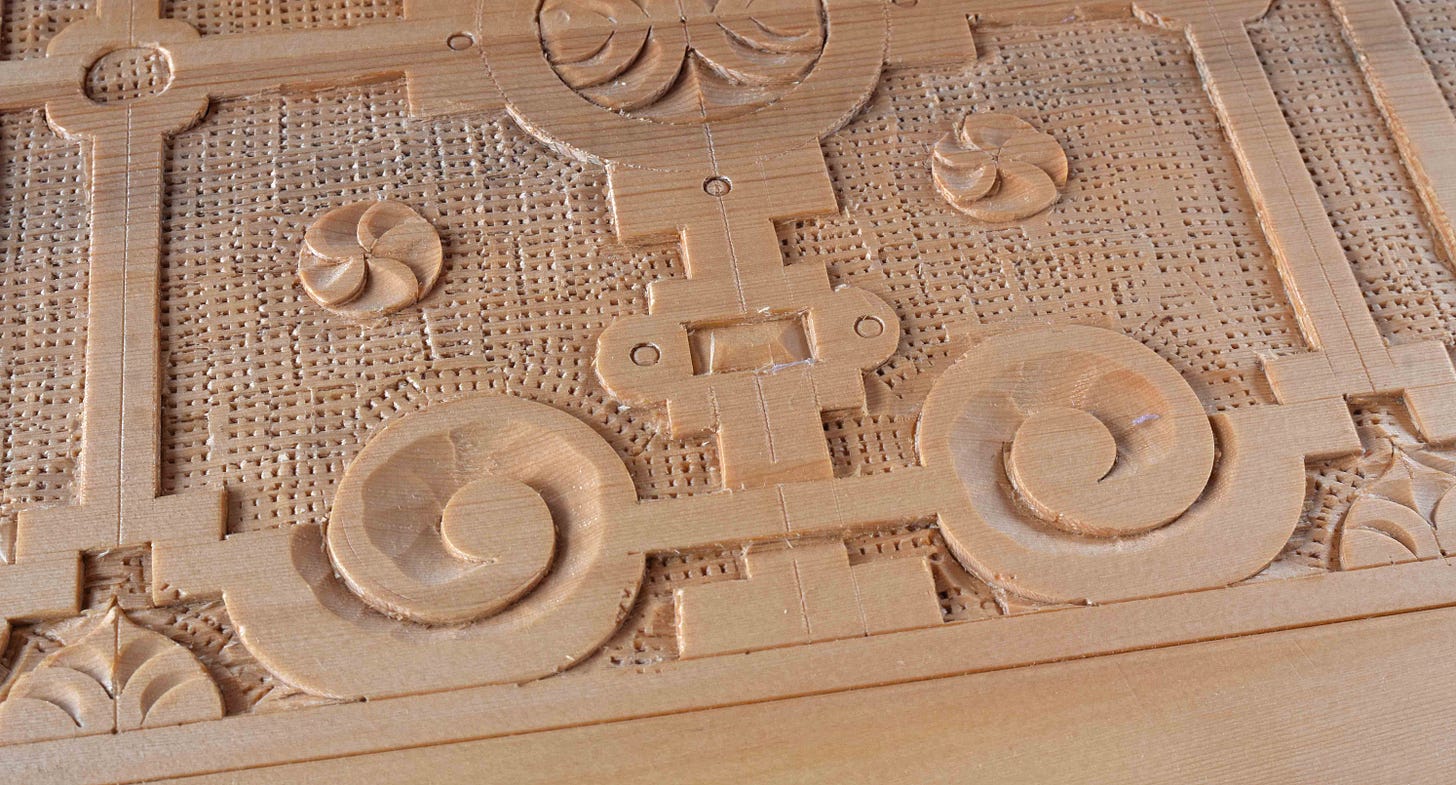Last week I wrote about three chairs - a ladderback, a continuous arm Windsor and a European-style board-chair. The ladderback and Windsors were chairs I used to make a lot. Then there was a long period in which I made none of them - but I was still making chairs.
Between 1994 and 2014 I must have made about 20 “wainscot” chairs. These are 17th-century style oak chairs joined with rectangular mortise and tenon joints, with one or more framed panels forming the back. Usually with turned front stiles. Beastly heavy, this one is close to 40 pounds I’d guess.
It was going to be a demo during a Fine Woodworking event in 2020, but like everything else then, that got canceled. I had the parts begun so finished it off that year & liked the carving so much I decided to keep it. This particular one is based on two well-known (to a small group of furniture history nuts) examples made in Ipswich Massachusetts between 1660s-1700. The originals were probably made by Thomas Dennis, both descended in his family. One is now at the Peabody Essex Museum in Salem, Massachusetts, the other is at the Bowdoin College art museum in Brunswick, Maine.
I’ve copied it a few times, each one changing the panel a bit here and there. This panel is a design I made up using period elements, just combined in a new sequence.
It’s not uncomfortable, just smaller than it looks. Especially width-wise.
Another iconic 17th century chair is this turned, board-seated chair that I made for a customer in 2018.
Ash with an oak seat. This one is based on two chairs at Pilgrim Hall in Plymouth Massachusetts. One belonged to Governor Bradford and the other to William Brewster. Brewster died in 1644 - meaning his chair is pretty “early.” They’re made of local ash, hence not brought over on the Mayflower. Clearly a technical challenge, they’re horrible to sit in.
The main feature to me is the way the seat rails intersect. The seat is a beveled panel fitting into grooves in the four seat rails. Thus they have to all be in the same plane. The turners of the period solved this by making intersecting joints - in this case a large rectangular tenon pierced by a round tenon. Some chairs have large and small turned tenons. Nice thing about the rectangular tenon is that the seat rail can’t spin if the joints ever come loose. Big heavy parts, seat rails 1 3/4” in diameter, posts maybe 2”. And a great many holes to bore. Below is a detail of the intersecting joints, this time in a 3-legged version.
An in-between chair I made is this turned chair with a bark seat.
I “made this one up” - it’s not a copy of an existing chair like the two previous examples. But the notion is found in Dutch paintings of the period quite frequently. A slat-back chair with flat arms. Heavy again. Usually a rush seat in the period, I chose hickory bark for this one. I think I made it in 2001.
Back to the wainscot chair - the rail just below the crest is another carving I have a soft spot for.
We call this sort of pattern “strapwork” because of the bands or strips that run horizontally and vertically connecting the elements. In 17th century New England furniture it’s only found on Thomas Dennis’ work (& maybe his predecessor in Ipswich, William Searle - it’s a long story) and is common enough in Devon, England where Searle was from (and where we suspect Dennis was from, but have no record of him there.)
I have carved it a lot over the years on anything that will stand still.
Some examples are included in a set of carving drawings that I sell for students who want to explore these designs. The 2nd set has a page full of strapwork designs and related patterns.
https://pfollansbee.wordpress.com/carving-drawings-plans/
I did some videos to go with these patterns... https://www.youtube.com/@MrFollansbee/videos
https://www.youtube.com/playlist?list=PLB2LcmbKpkcYGweT2rnyRQysMee6vWKVW











I recently booked a commission for walnut boxes for urns with strap work carving. 4 of them. Excited to get them underway.
The Brewster/Bradford chair does not look like fun to make, or to sit in. The base does look like a good place to trap a crawling baby.